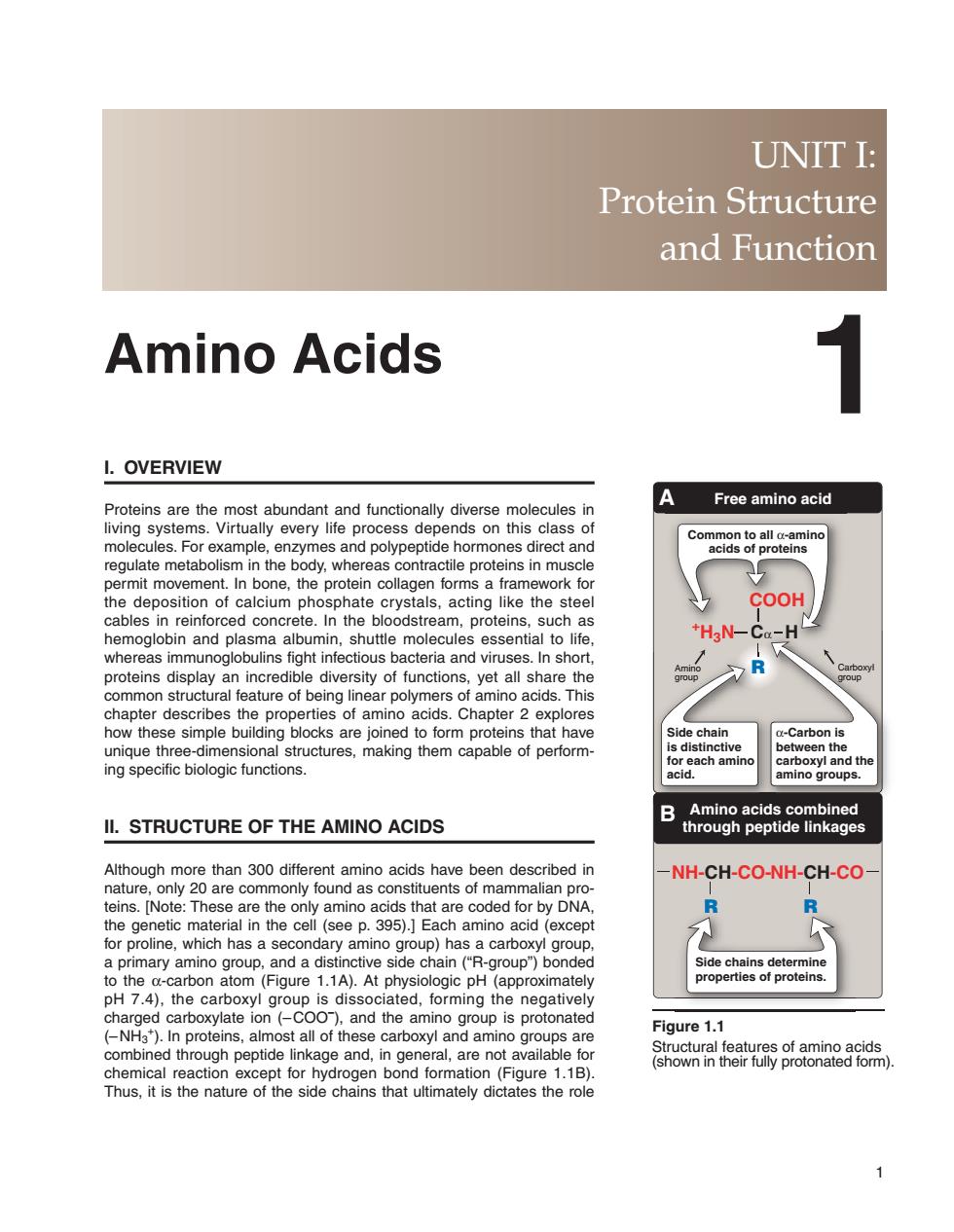正在加载图片...

UNIT I: Protein Structure and Function Amino Acids I.OVERVIEW Free amino acid Proteins are the most abundant and functionally diverse molecules in ly every Common to reulate metabolism in the body.whereas contractile proteins in muscle permit movement.In bone,the protein collagen forms a framework for of calcium phosphate cryst acting like the stee COOH hemoglobin and plasma albumin.shuttle to whereas immunoglobulins fight infectious bacteria and viruses.In short, R ature of b ing near how these simple building blocks are ioined to form proteins thaave chain o-Carbon is unique three-dimensional structures,making them capable of perform- h an ng specific b logic functions. acid mino groups. ine IL.STRUCTURE OF THE AMINO ACIDS Although more than 300 different amino acids have been described in NH-CH-CO-NH-CH-CO nature,only 20 are commonly found as constituents of mammalian pro iens.Note:Theeairth e only amino ac shat are coded for by DNA hich has a primary amino group,and a distinctive side chain("R-group)bonded e cha m(re.A At physo H the car boxyl rming th (NH.In proteins.aimost all of these carboxyl and amino groups are Figure 1.1 combined through peptide linkage and,in general,are not available for m exce ogen b e ne chains thaAmino Acids 1 I. OVERVIEW Proteins are the most abundant and functionally diverse molecules in living systems. Virtually every life process depends on this class of molecules. For example, enzymes and polypeptide hormones direct and regulate metabolism in the body, whereas contractile proteins in muscle permit movement. In bone, the protein collagen forms a framework for the deposition of calcium phosphate crystals, acting like the steel cables in reinforced concrete. In the bloodstream, proteins, such as hemoglobin and plasma albumin, shuttle molecules essential to life, whereas immuno globulins fight infectious bacteria and viruses. In short, proteins display an incredible diversity of functions, yet all share the common structural feature of being linear polymers of amino acids. This chapter describes the properties of amino acids. Chapter 2 explores how these simple building blocks are joined to form proteins that have unique three-dimensional structures, making them capable of performing specific biologic functions. II. STRUCTURE OF THE AMINO ACIDS Although more than 300 different amino acids have been described in nature, only 20 are commonly found as constituents of mammalian proteins. [Note: These are the only amino acids that are coded for by DNA, the genetic material in the cell (see p. 395).] Each amino acid (except for proline, which has a secondary amino group) has a carboxyl group, a primary amino group, and a distinctive side chain (“R-group”) bonded to the α-carbon atom (Figure 1.1A). At physiologic pH (approximately pH 7.4), the carboxyl group is dissociated, forming the negatively charged carboxylate ion (–COO– ), and the amino group is protonated (–NH3 +). In proteins, almost all of these carboxyl and amino groups are combined through peptide linkage and, in general, are not available for chemical reaction except for hydrogen bond formation (Figure 1.1B). Thus, it is the nature of the side chains that ultimately dictates the role Figure 1.1 Structural features of amino acids (shown in their fully protonated form). C +H3N NH-CH-COCOOH C H +H3N COOH H Common to all α-amino acids of proteins Free amino acid Amino acids combined through peptide linkages R R NH-CH-CO R Amino group Carboxyl group Cα H Carboxyl group α Amino R group R Side chain is distinctive for each amino acid. α-Carbon is between the carboxyl and the amino groups. R R Side chains determine properties of proteins. A B 1 UNIT I: Protein Structure and Function 168397_P001-012.qxd7.0:02 Protein structure 5-20-04 2010.4.4 9:45 AM Page 1